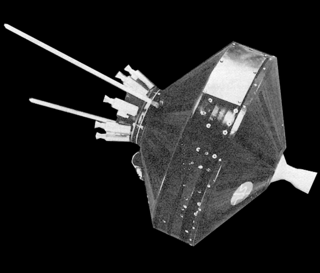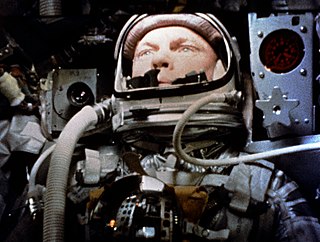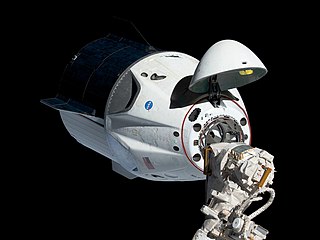
Project Mercury was the first human spaceflight program of the United States, running from 1958 through 1963. An early highlight of the Space Race, its goal was to put a man into Earth orbit and return him safely, ideally before the Soviet Union. Taken over from the US Air Force by the newly created civilian space agency NASA, it conducted 20 uncrewed developmental flights, and six successful flights by astronauts. The program, which took its name from Roman mythology, cost $2.68 billion. The astronauts were collectively known as the "Mercury Seven", and each spacecraft was given a name ending with a "7" by its pilot.

Atmospheric entry is the movement of an object from outer space into and through the gases of an atmosphere of a planet, dwarf planet, or natural satellite. Atmospheric entry may be uncontrolled entry, as in the entry of astronomical objects, space debris, or bolides. It may be controlled entry of a spacecraft that can be navigated or follow a predetermined course. Methods for controlled atmospheric entry, descent, and landing of spacecraft are collectively termed as EDL.

Pioneer 2 was the last of the three project Able space probes designed to probe lunar and cislunar space. The launch took place at 07:30:21 GMT on 8 November 1958. After Pioneer 1 had failed due to guidance system deficiencies, the guidance system was modified with a Doppler command system to ensure more accurate commands and minimize trajectory errors. Once again, the first and second stage portion of the flight was uneventful, but the third stage of the launch vehicle failed to ignite, making it impossible for Pioneer 2 to achieve orbital velocity. An attempt to fire the vernier engines on the probe was unsuccessful and the spacecraft attained a maximum altitude of 1,550 km (960 mi) before reentering Earth's atmosphere at 28.7° N, 1.9° E over NW Africa.

Pioneer 1 was an American space probe, the first under the auspices of NASA, which was launched by a Thor-Able rocket on 11 October 1958. It was intended to orbit the Moon and make scientific measurements, but due to a guidance error failed to achieve lunar orbit and was ultimately destroyed upon reentering Earth's atmosphere. The flight, which lasted 43 hours and reached an apogee of 113,800 km, was the second and most successful of the three Thor-Able space probes.

Mercury-Atlas 6 (MA-6) was the first crewed American orbital spaceflight, which took place on February 20, 1962. Piloted by astronaut John Glenn and operated by NASA as part of Project Mercury, it was the fifth human spaceflight, preceded by Soviet orbital flights Vostok 1 and 2 and American sub-orbital flights Mercury-Redstone 3 and 4.

Mercury-Atlas 7, launched May 24, 1962, was the fourth crewed flight of Project Mercury. The spacecraft, named Aurora 7, was piloted by astronaut Scott Carpenter. He was the sixth human to fly in space. The mission used Mercury spacecraft No. 18 and Atlas launch vehicle No. 107-D.

Gemini 1 was the first mission in NASA's Gemini program. An uncrewed test flight of the Gemini spacecraft, its main objectives were to test the structural integrity of the new spacecraft and modified Titan II launch vehicle. It was also the first test of the new tracking and communication systems for the Gemini program and provided training for the ground support crews for the first crewed missions.

Saturn-Apollo 3 (SA-3) was the third flight of the Saturn I launch vehicle, the second flight of Project Highwater, and part of the American Apollo program. The rocket was launched on November 16, 1962, from Cape Canaveral, Florida.

Gemini 11 was the ninth crewed spaceflight mission of NASA's Project Gemini, which flew from September 12 to 15, 1966. It was the 17th crewed American flight and the 25th spaceflight to that time. Astronauts Pete Conrad and Dick Gordon performed the first direct-ascent rendezvous with an Agena Target Vehicle, docking with it 1 hour 34 minutes after launch; used the Agena rocket engine to achieve a record high-apogee Earth orbit; and created a small amount of artificial gravity by spinning the two spacecraft connected by a tether. Gordon also performed two extra-vehicular activities for a total of 2 hours 41 minutes.

Big Joe 1 (Atlas-10D) launched an uncrewed boilerplate Mercury capsule from Cape Canaveral, Florida on 9 September 1959. The purposes of the Big Joe 1 were to test the Mercury spacecraft ablative heat shield, afterbody heating, reentry dynamics attitude control and recovery capability. It was also the first launch of a spacecraft in Project Mercury.

Mercury-Atlas 2 (MA-2) was an uncrewed test flight of the Mercury program using the Atlas rocket. It launched on February 21, 1961, at 14:10 UTC, from Launch Complex 14 at Cape Canaveral, Florida, United States.

A space capsule is a spacecraft designed to transport cargo, scientific experiments, and/or astronauts to and from space. Capsules are distinguished from other spacecraft by the ability to survive reentry and return a payload to the Earth's surface from orbit or sub-orbit, and are distinguished from other types of recoverable spacecraft by their blunt shape, not having wings and often containing little fuel other than what is necessary for a safe return. Capsule-based crewed spacecraft such as Soyuz or Orion are often supported by a service or adapter module, and sometimes augmented with an extra module for extended space operations. Capsules make up the majority of crewed spacecraft designs, although one crewed spaceplane, the Space Shuttle, has flown in orbit.

The Scout family of rockets were American launch vehicles designed to place small satellites into orbit around the Earth. The Scout multistage rocket was the first orbital launch vehicle to be entirely composed of solid fuel stages. It was also the only vehicle of that type until the successful launch of the Japanese Lambda 4S in 1970.

The Minotaur is a family of United States solid-fuel launch vehicles repurposed from retired Minuteman and Peacekeeper model intercontinental ballistic missiles. Built by Northrop Grumman under the Space Force's Rocket Systems Launch Program, these vehicles are used for various space and test launch missions.

ASSET, or Aerothermodynamic Elastic Structural Systems Environmental Tests was an experimental US space project involving the testing of an uncrewed sub-scale reentry vehicle.

Antares, known during early development as Taurus II, is an American expendable medium-lift launch vehicle developed and built by Orbital Sciences Corporation with financial support from NASA under the Commercial Orbital Transportation Services (COTS) program awarded in February 2008, alongside the company's automated cargo spacecraft, Cygnus. Like other launch vehicles developed by Orbital, Antares leveraged lower-cost, off-the-shelf parts and designs.

Orbital-2, also known as Orb-2, was the third flight of the Orbital Sciences' uncrewed resupply spacecraft Cygnus, its third flight to the International Space Station, and the fourth launch of the company's Antares launch vehicle. The mission launched from the Mid-Atlantic Regional Spaceport (MARS) on 13 July 2014 at 16:52:14 UTC.

Non-ballistic atmospheric entry is a class of atmospheric entry trajectories that follow a non-ballistic trajectory by employing aerodynamic lift in the high upper atmosphere. It includes trajectories such as skip and glide.

OA-6, previously known as Orbital-6, is the sixth flight of the Orbital ATK uncrewed resupply spacecraft Cygnus and its fifth flight to the International Space Station under the Commercial Resupply Services (CRS) contract with NASA. The mission launched on 23 March 2016 at 03:05:52 UTC.

OA-7, previously known as Orbital-7, is the eighth flight of the Orbital ATK uncrewed resupply spacecraft Cygnus and its seventh flight to the International Space Station (ISS) under the Commercial Resupply Services contract with NASA. The mission launched on 18 April 2017 at 15:11:26 UTC. Orbital and NASA jointly developed a new space transportation system to provide commercial cargo resupply services to the International Space Station (ISS). Under the Commercial Orbital Transportation Services (COTS) program, then Orbital Sciences designed and built Antares, a medium-class launch vehicle; Cygnus, an advanced maneuvering spacecraft, and a Pressurized Cargo Module which is provided by Orbital's industrial partner Thales Alenia Space.































